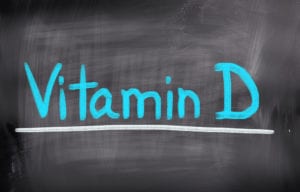Written by Joyce Smith, BS. This study found an inverse association between serum vitamin D levels and SARS-CoV-2 positivity rates.
 Studies have linked Vitamin D deficiency to an increased risk of viral upper respiratory tract infections and SARS-CoV-2 (COVID-19) mortality 1,2. Vitamin D impacts both the innate and adaptive immune systems 3 to help tame the Cytokine storm (excessive cytokine release) that is responsible for the severe illness and death in COVID-19 patients 4. Previous studies have explored COVID-19 outcomes relative to Vitamin D status in people living at different latitudes 1,5 but with conflicting results 6,7; thus reinforcing the need to determine the degree to which vitamin D levels influence SARS-CoV-2 positivity rates.
Studies have linked Vitamin D deficiency to an increased risk of viral upper respiratory tract infections and SARS-CoV-2 (COVID-19) mortality 1,2. Vitamin D impacts both the innate and adaptive immune systems 3 to help tame the Cytokine storm (excessive cytokine release) that is responsible for the severe illness and death in COVID-19 patients 4. Previous studies have explored COVID-19 outcomes relative to Vitamin D status in people living at different latitudes 1,5 but with conflicting results 6,7; thus reinforcing the need to determine the degree to which vitamin D levels influence SARS-CoV-2 positivity rates.
In a retrospective observational study, 8 researchers examined whether circulating 25-hydroxyvitamin D (25(OH)D) levels are associated with SARS-CoV-2 positivity rates. They analyzed de-identified SARS-CoV-2RNANAAT tests that Quest Diagnostics clinical laboratories had assessed using nucleic acid amplification testing (NAAT). Included were test results of over 190,000 patients from all 50 states who had SARS-CoV-2 tests done at the lab from mid-March through mid-June of 2020 along with matching 25(OH)D results from the preceding 12 months. Researchers matched residential zip code data with US Census data to analyze the impact of race/ethnicity and geographical latitudes on vitamin D levels and positive SARS-CoV-2 tests.
A total of 191,779 patients were included in the analysis. The positive SARS-CoV-2 test risk was 54% higher in patients with “deficient” 25(OH)D values of less than 20 ng/mL) (12.5%, 95% C.I. 12.2–12.8%) compared to patients with “adequate” values of 30–34 ng/mL (8.1%, 95% C.I. 7.8–8.4%) and patients with values equal to or above 55 ng/mL (5.9%, 95% C.I. 5.5–6.4%). The risk of a positive SARS-CoV-2 test continued to decline until the serum levels reached 55 ng/mL.
Patients with the lowest circulating levels of 25(OH) D had approximately a 5–7% higher rate of positive SARS-CoV-2 tests across northern, central, and southern latitudes. More patients in black non-Hispanic populations and in Hispanic populations tested positive for SASR-CoV-2 than patients from predominately white non-Hispanic populations at every 25(OH)D level (P=0.001 for both).
SARS-CoV-2 NAAT positivity rate was found to be strongly and inversely associated with circulating 25(OH) D levels. This relationship persisted across latitudes, races/ethnicities, sexes, and age ranges. Researchers suggest a need for additional studies to explore the role of vitamin D supplementation in reducing the risk for SARS-CoV-2 infection and COVID-19 disease. If further controlled trials validate a causal relationship between vitamin D levels and SARS-CoV-2 infection, vitamin D supplementation would be an inexpensive and readily available means of infection prevention especially for those with vitamin D deficiency. This would be very significant for the African American and Hispanic communities who are disproportionately affected by both COVID-19 and vitamin D deficiency. Until such time, the authors recommend responsible vitamin D supplementation based on personal needs, risk factors, and personal physician advice that aligns with the existing Endocrine Society Guidelines. 9
Source: Kaufman, Harvey W., Justin K. Niles, Martin H. Kroll, Caixia Bi, and Michael F. Holick. “SARS-CoV-2 positivity rates associated with circulating 25-hydroxyvitamin D levels.” PLoS One 15, no. 9 (2020): e0239252.
© 2020 Kaufman et al. This is an open access article distributed under the terms of the Creative Commons Attribution License.
Click here to read the full text study.
Posted January 26, 2021.
Joyce Smith, BS, is a degreed laboratory technologist. She received her bachelor of arts with a major in Chemistry and a minor in Biology from the University of Saskatchewan and her internship through the University of Saskatchewan College of Medicine and the Royal University Hospital in Saskatoon, Saskatchewan. She currently resides in Bloomingdale, IL.
References:
- Rhodes J, Dunstan F, Laird E, Subramanian S, Kenny RA. COVID-19 mortality increases with northerly latitude after adjustment for age suggesting a link with ultraviolet and vitamin D. BMJ nutrition, prevention & health. 2020;3(1):118-120.
- Kohlmeier M. Avoidance of vitamin D deficiency to slow the COVID-19 pandemic. BMJ nutrition, prevention & health. 2020;3(1):67-73.
- Zdrenghea MT, Makrinioti H, Bagacean C, Bush A, Johnston SL, Stanciu LA. Vitamin D modulation of innate immune responses to respiratory viral infections. Reviews in medical virology. 2017;27(1).
- Mehta P, McAuley DF, Brown M, Sanchez E, Tattersall RS, Manson JJ. COVID-19: consider cytokine storm syndromes and immunosuppression. Lancet. 2020;395(10229):1033-1034.
- Grant WB, Lahore H, McDonnell SL, et al. Evidence that Vitamin D Supplementation Could Reduce Risk of Influenza and COVID-19 Infections and Deaths. Nutrients. 2020;12(4).
- D’Avolio A, Avataneo V, Manca A, et al. 25-Hydroxyvitamin D Concentrations Are Lower in Patients with Positive PCR for SARS-CoV-2. Nutrients. 2020;12(5).
- Hastie CE, Mackay DF, Ho F, et al. Vitamin D concentrations and COVID-19 infection in UK Biobank. Diabetes & metabolic syndrome. 2020;14(4):561-565.
- Kaufman HW, Niles JK, Kroll MH, Bi C, Holick MF. SARS-CoV-2 positivity rates associated with circulating 25-hydroxyvitamin D levels. PLoS One. 2020;15(9):e0239252.
- Holick MF, Binkley NC, Bischoff-Ferrari HA, et al. Evaluation, treatment, and prevention of vitamin D deficiency: an Endocrine Society clinical practice guideline. The Journal of Clinical Endocrinology & Metabolism. 2011;96(7):1911-1930.
